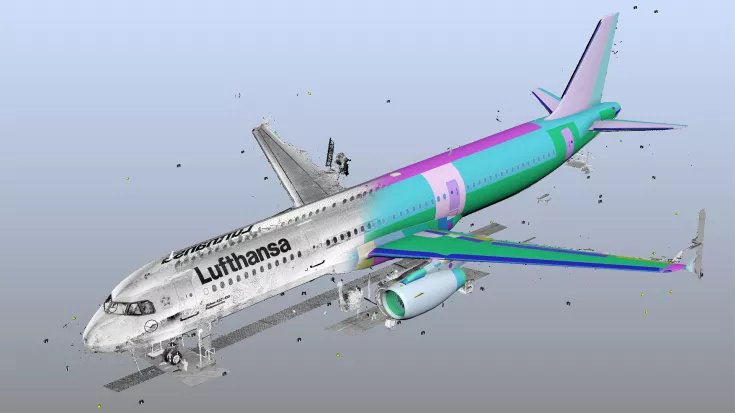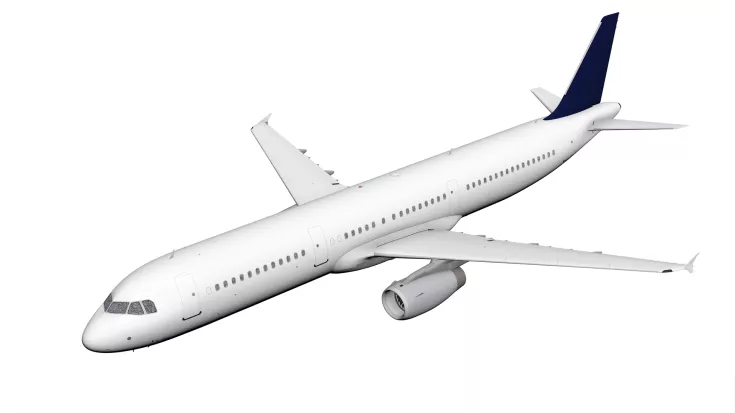3D Laser Scanning in Aircraft Construction

TitlePrecision in aviation: 3D laser scanning for aircraft construction
The aviation industry places the highest demands on accuracy and efficiency – be it in the construction, maintenance or modernization of aircraft. This is where 3D laser scanning comes into play: this cutting-edge technology can be used to capture and digitize entire aircraft structures, individual components and complex interiors in great detail.
Whether for the development of new aircraft, the maintenance of existing models or the reverse engineering of components that are no longer produced – 3D scanning offers an indispensable solution to the challenges of aviation.
TitleWhy 3D scanners are becoming increasingly important in the aviation industry
The aviation industry is facing ever-increasing demands for precision, efficiency and safety. 3D scanners play a decisive role here, as they enable fast, non-contact and high-precision capture of complex aircraft structures.
Laser scanners provide exact digital images of components and complete aircraft. This not only facilitates quality control and fault analysis, but also significantly speeds up production and repair processes.
In view of increasing demands for fuel efficiency, lighter materials and ever more complex designs, the use of 3D scanning technologies has become indispensable for manufacturers, maintenance companies and engineers.
TitleNew surveying method with more accurate results
3D scanning is primarily used when modifications or aerodynamic investigations are carried out on aircraft. The laser scanner is often the only way to obtain 3D data, as this is rarely available due to a lack of provision on the part of the manufacturer. In addition to aircraft, devices for the production of aircraft parts can also be scanned, for example special facilities such as wind tunnels or turbine test stands.
While manual measurements and tactile methods only provide punctual data, laser scanners capture millions of measuring points per second and generate a complete, three-dimensional point cloud. This allows even the smallest deviations or damage to be analyzed in detail without having to dismantle the component. This not only saves time, but also significantly improves quality assurance and efficiency in the aviation industry.
TitleAreas of application for 3D scanning in aircraft construction
3D laser scanning is used in many areas of the aviation industry to optimize processes and ensure maximum precision:
- Development & design:
- Rapid capture and digital modeling of components
- Optimization of design processes and more efficient prototyping
- Quality control:
- High-precision measurement to ensure compliance with specifications
- Avoid expensive reworking thanks to early error detection
- Maintenance & repair:
- Capturing the actual condition of aircraft structures
- Identification of wear or damage for targeted repairs
- Reverse engineering:
- Digital reconstruction of no longer documented or obsolete components
- Creation of precisely fitting spare parts without original drawings
- Aerodynamics research:
- Surface analyses to optimize flow properties
- Improving efficiency and fuel savings through precise measurements
Thanks to these versatile applications, 3D laser scanning makes a decisive contribution to efficiency, safety and innovation in the aviation industry.
TitleLess reworking due to high degree of prefabrication
Thanks to high-precision data acquisition with 3D laser scanners, components and structures in aircraft construction can be prefabricated with extreme accuracy. Entire aircraft or just individual parts can therefore be planned and manufactured in detail. The high degree of prefabrication greatly reduces rework during assembly.
The detailed digital models enable potential corrections to be identified and rectified during the planning phase. This minimizes reworking on site, saves material and personnel costs and ensures more efficient and error-free production.
Continuous measurement is required during the individual production phases in order to guarantee the precision required for a perfectly fitting design.
TitlePrecise design basis thanks to 3D laser scanning
Thanks to its high-precision 3D data, three-dimensional measurement provides an ideal basis for subsequent design and planning processes. With 3D laser scanning, even complex geometries and multi-curved surfaces can be captured without gaps – a decisive advantage, especially in the aviation industry, where maximum dimensional accuracy is required. The captured data enables a detailed 3D surface inspection to check whether components correspond exactly to the given specifications or whether there are any deviations.
In addition to dimensional accuracy checks, the generated point clouds can be used to create digital surface and volume models that serve as the basis for further design steps. Collision checks can also be carried out to ensure that new components can be seamlessly integrated into existing structures. This reduces development times, minimizes sources of error and ensures more efficient and cost-saving production.
TitleOptimized processes in aircraft construction thanks to digital measurements
Time and costs are reduced thanks to the fast, precise recording and simple planning and modeling on the digital model. The high accuracy of fit also eliminates the need for time-consuming reworking.
Due to the numerous possibilities when planning on the digital model, top performance can be achieved and profit-increasing solutions created in production.
Laser scanning also offers new possibilities for reverse engineering, assembly automation and final inspections. This sets new standards in quality assurance in aircraft construction.
TitleFaster & easier installation thanks to accurate data
Aircraft construction places the highest demands on measurement technology, especially when it comes to measuring individual components and the entire assembly process. Every component must be manufactured and assembled with millimeter precision in order to meet the highest safety and quality standards.
Thanks to fast and uncomplicated measurement with a laser scanner, components can be precisely recorded and transferred directly into digital construction models. This not only reduces the workload, but also enables more efficient quality assurance. In addition, fewer personnel are required for manual measuring tasks, which means that skilled workers can be deployed for other important activities.
TitleOur services in the documentation of aircraft
- 3D scanning of aircraft structures (outer shell, wings, tail units, landing gear or turbines)
- 3D scanning of aircraft interiors (e.g. cockpit, cabin, bin, galley)
- Scanning with small and large-volume 3D scanners (strip light scanners, hand-held scanners)
- Creation of an overall model using different scanner types
- Export of scan data in standard industry formats or generation of surfaces
TitleWho is our service for?
Engineers and designers in particular rely on our support for the precise capture of aircraft components and complete models using 3D scanners.
Thanks to our many years of experience in the aviation industry, we are very familiar with the specific requirements of various aircraft manufacturers. We have already successfully implemented numerous measurement projects for models from Boeing, Airbus, Embraer and Bombardier. In addition to civil aircraft, we also measure military aircraft, including fighter jets and helicopters, with the highest precision.







